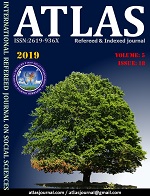TUR ABDİN HRİSTİYAN DİNİ MİMARİSİNDE MANASTIR GELENEĞİ
DOI:
https://doi.org/10.31568/atlas.315Anahtar Kelimeler:
Tur Abdin, Asketizm, Münzevilik, Hristiyan ManastırlarıÖzet
Tur Abdin bölgesi, Hristiyanlık inancının gelişip olgunlaştığı ve yayılım alanı bulduğu bir coğrafya olma özelliğine sahiptir. Bölge, Hristiyanlık teolojisi ve temel öğretilerinin sistematik şekilde ele alınıp bir program çerçevesinde öğretildiği manastırlara ev sahipliği yapmıştır. İlk etapta münzevi bir keşiş etrafında gelişen ve daha sonra sistemli bir kurum haline gelen manastır yapıları Tur Abdin bölgesi Hristiyan dini mimarisinin temel karakterini yansıtması açısından oldukça önemli bir yere sahiptir. Süryani dini mimarisine ait bu yapılar bize bölgenin dini mimarisi hakkında gerekli ipuçlarını vermektedir. Tur Abdin, gerek bulunduğu konum gerekse bünyesinde barındırdığı Hristiyan dini mimarisine ait örnekler ile geçmişte olduğu gibi günümüzde de önemini korumaya devam etmektedir. Manastırlar genellikle yerleşim yerinden uzak ve ulaşılması daha güç olan bölgelere inşa edilmişlerdir. Tur Abdin bölgesinde yer alan manastırların birçoğu da aynı şekilde yerleşim yerlerinden uzak alanlara yapılmışlardır. Asketik yani çileci bir yaşam şeklini seçen ve bu doğrultuda hayatını sürdüren din adamlarının etrafında gelişen bu kurumlar Hristiyanlık inancı açısından temel birer yapı taşı mahiyetinde olmuşlardır. Genel yapı itibariyle Tur Abdin bölgesinde bulunan manastırlardan bazılarının günümüze kadar sağlam bir şekilde gelebilmiş olması, konunun daha iyi anlaşılması açısından bize oldukça somut fikirler sunmaktadır. Manastır geleneği bölge de erken tarihlerde yayılamaya başlamış ve zaman içerisinde gelişerek kapsamlı birer kurum haline gelmiştir. Tur Abdin, Hristiyan dini mimarisi açısından oldukça zengin bir bölge konumundadır. Bölgede merkezi bir konumda yer alan Midyat İlçesi başta olmak üzere geniş bir alanda yayılım göstermektedir. Süryanilere ait bu manastır yapılarında, Ortodoks mezhebi ağırlıkta olmak üzere, Hristiyan inancının temel ilkeleri ve dini esasları belli bir sistem çerçevesinde öğretilmektedir. Tur Abdin bölgesi ile ilgili genel bir bilgi verildikten sonra, araştırma konumuzu teşkil eden ve bölgede Hristiyanlığın gelişip yayılmasına önemli derecede katkı sağlayan bu dini mimari örneklerinin, kuruluş ve gelişim evreleri hakkında kısa bilgiler verilecektir. En son aşamada ise, bölgede yer alan manastırların plan ve mimari özellikleri hakkında genel bir değerlendirme yapılması hedeflenmektedir.
İndir
Yayınlanmış
Nasıl Atıf Yapılır
Sayı
Bölüm
Lisans

Bu çalışma Creative Commons Attribution-NonCommercial 4.0 International License ile lisanslanmıştır.


